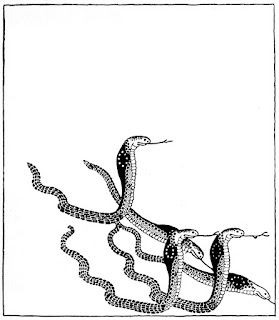Caution: Idea not yet table tested.
If you, like me, are always on the lookout for TTRPG simplicity and conciseness, here's a dice roll you can overload with extra meaning.
In a random encounter table, list the "numbering appearing" dice code with a negative modifier. If the result is zero or fewer creatures, it means the PCs have come across recently-left signs of such creatures, in the form of tracks or spoor which the characters might or might not choose to follow.
If the GM ever does need to find the number appearing of these regionally nearby creatures, roll again without the negative modifier.
For example:
Instead of, say, 1d6 ogres, the random encounter table lists 2d6–4 ogres. The range is slightly greater (0-8 instead of 1-6) and the average is similar (3 instead of 3.5). If the GM rolls snake eyes, no ogres are here; instead, perhaps, large footprints and gnawed cooked bones. The PCs follow the tracks, so the GM rolls again (2d6 this time) to see how many ogres are camped a day or so away.Now, you can obviously accomplish similar results in other ways. Most systems do. Why do it like this?
Key benefits:
- Minimalism via overloading. You no longer need a separate roll for signs/tracks/spoor.
- Reminder. The GM won't accidentally neglect to include reminders that fictive content is everywhere (i.e. elsewhere), and not always served up to the PCs on a platter. The world feels populated.
- Scaling and choice. This method automatically results in nearby groups of possibly greater numbers, creating something in between an 'easy random encounter' and a planned challenge. This allows you to define the size of creature groups with an upper limit higher than the one you'd randomly inflict on the PCs at an inopportune moment. Look at the example above. Suppose you have four PCs who can each take on one ogre, but two each is a big risk and three each is exceptionally dangerous. Rolling 2d6–4, a random encounter will usually serve up about 3 ogres, but very rarely as many as 8, and the PCs can discover ogre tracks and cautiously scout them to find a group of (on average) 7, but possibly as many as 12. It becomes a PC choice as to whether to push their luck, which is always a good thing: the GM doesn't have to waste extra time on balancing or 'fudge outcomes' (cheat).
- Standardisation. If you're adding a negative modifier, you'll often be adding more dice to compensate, resulting in a steeper probability curve. As a result, the GM has a slightly better idea of how many creatures will tend to show up to an encounter. If you specifically don't want that, it's easy enough to use larger dice sizes instead, or add a multiplier (say, [1d6–2]×5 instead of 5d6–10).
- Extensibility. You could overload the 'number appearing' roll further, adding ideas like exploding dice. Let's say a maximum roll means the PCs have found a monster lair and that's how many creatures are lounging around the entrance or on guard. Roll again without the negative modifier to see how many creatures are deeper in the lair.
Main issues to be resolved:
- If your system has a separate roll for non-creature encounters that includes things like notable environmental and weather effects as well as tracks/spoor, then you aren't really any better off this way.
- The mathematical conversion quickly becomes non-trivial as "number appearing" increases. Many GMs won't be able to do a representative conversion of an existing encounter table entry at a glance or on the fly even with relatively simple dice codes. And even with a good grounding in dice probabilities, it still takes time and effort to convert 8d8 to e.g. [4d10–10]×2 (if you care that the larger likely numbers appearing stay about the same), or else to e.g. [5d8–15]×4 (if you care that the average number appearing is similar but don't mind sometimes getting lots more), or even to e.g. 6d20–50 (if you want lots of tracks and lots of variation).





